AACtual Therapy with Deanna Wagner: Why Cook When You Can’t Eat?
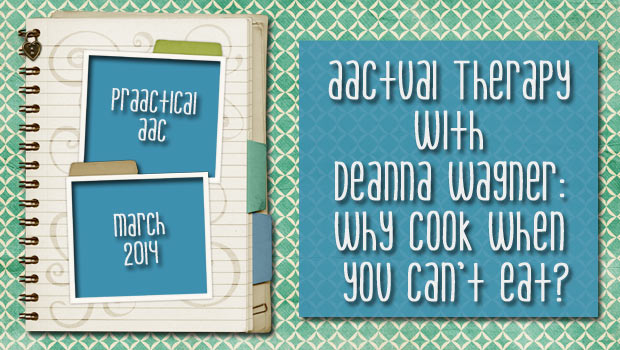
One of our prAACtical friends loves to think about, talk about, and participate in anything to do with baking. Not all that unusual unless you consider that he has a g-tube and doesn’t eat in the conventional sense. So we were incredibly excited have this guest post by SLP Deanna Wagner, whose prAACtical ideas for teaching AAC using cooking activities appealed to us right away. You can read more about 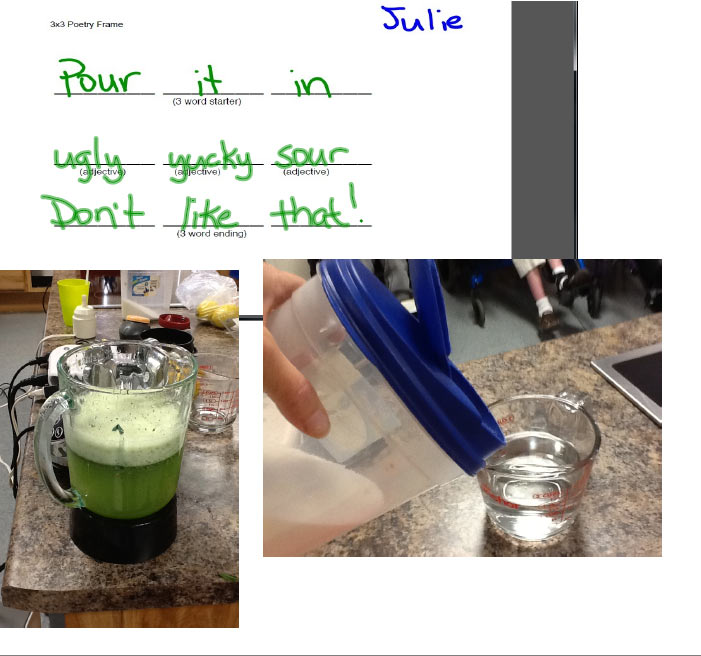 Deanna here.
Deanna here.
Why Cook When You Can’t Eat?
I have been thinking about writing this post for a number of weeks, now. And have come up with many different answers to this question, “Why cook when you can’t eat?” I finally decided I should just talk about how we use cooking activities to reinforce communication skills and let the reader can come up with his/her own answer to this question. Whether I am working in a school classroom or with adults at the Day Program, I like cooking in a group. Even more important than requesting, we work on describing, commenting, and sequencing. Check out these dynamics:
Before Cooking
We talk about ingredients we will use. This may begin by talking about how something can help cool us down on a hot day (or warm us up) or foods that are used by different people to celebrate various holidays. We use Google Images to look at pictures of different ways people prepare foods/drinks. Comments and questions are encouraged. I like to look for items with bold colors, taste, or smell. Whenever possible, we try to work with fresh ingredients, just for that reason. Then we click on links and look for recipes. Some recipes 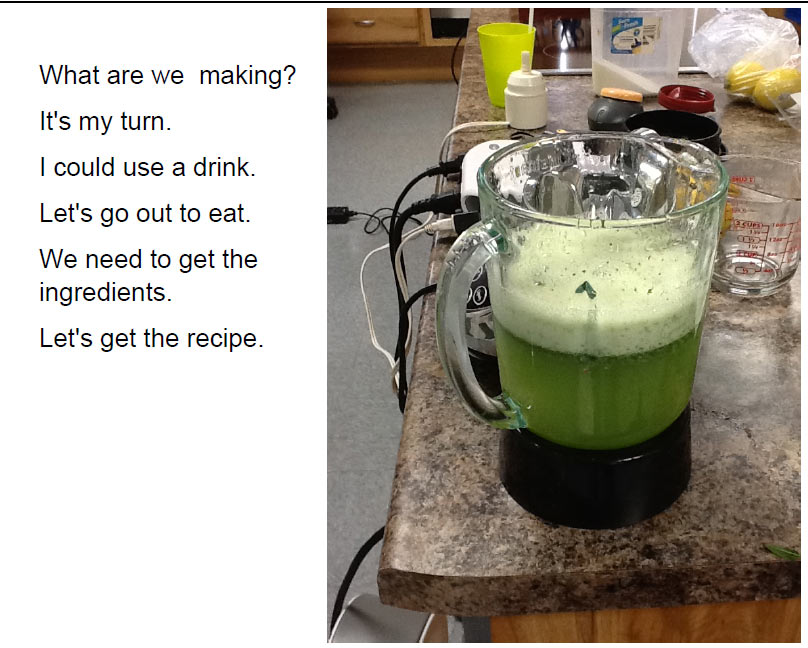 also have YouTube links with suggestions for best ways to prepare items. We try to pick out recipes that involve use of the blender, mixer, or food processor, so that everyone can participate. Then we vote. We print out a recipe. Finally, we make a grocery list. Items that are essential to the activity are added to devices. Sometimes, however, we talk about how similar vocabulary can be used to describe items rather than adding everything and having to learn new words. For example, when we made something called “limonana”, we practiced saying “green lemonade.” This drink is different from “limonada” the Spanish word for lemonade. According to Wikipedia, Limonana (Hebrew: לימונענע; Arabic: ليمون نعناع) is a type of lemonade made from freshly-squeezed lemon juice and mint leaves that is popular in Israel, the Palestinian territories, Egypt, Jordan, Lebanon, and Syria.
also have YouTube links with suggestions for best ways to prepare items. We try to pick out recipes that involve use of the blender, mixer, or food processor, so that everyone can participate. Then we vote. We print out a recipe. Finally, we make a grocery list. Items that are essential to the activity are added to devices. Sometimes, however, we talk about how similar vocabulary can be used to describe items rather than adding everything and having to learn new words. For example, when we made something called “limonana”, we practiced saying “green lemonade.” This drink is different from “limonada” the Spanish word for lemonade. According to Wikipedia, Limonana (Hebrew: לימונענע; Arabic: ليمون نعناع) is a type of lemonade made from freshly-squeezed lemon juice and mint leaves that is popular in Israel, the Palestinian territories, Egypt, Jordan, Lebanon, and Syria.
During Cooking We pause often to reflect on the colors, texture, and smells, not just the taste. And of course, we take pictures! We talk about how the stove is used to cook and the oven to bake; the blender for mixing liquids and the food processor for cutting. For individuals with phrase-based vocabulary, we simplify with “heat it up” and “mix it.” By using a switch and an environmental control unit, such as the PowerLink from Ablenet, everyone can ask to take a turn. Again, pausing is crucial. When I don’t get enough response from the group, I also throw in a little creative stupidity – such as omitting a step or threatening to put in the wrong ingredient or use the wrong tool. When making limonana, for example, we tasted it before adding all of the sugar, just to make sure we didn’t get it too sweet J. In addition to the blender, I also have an electric lemon squeezer – loads of fun!
the sugar, just to make sure we didn’t get it too sweet J. In addition to the blender, I also have an electric lemon squeezer – loads of fun!
After Cooking Immediately after making something, we usually taste and comment. Most of my students can at least have a small taste on their tongue without choking, though some will make the choice to just look and smell. I like to review pictures and do mini writing lessons after cooking. I am including an attachment to this blog with pictures from various writing assignments we did after making limonana. For those working on word-by-word sentence construction, we practiced wordsmithing a 3×3 poem, using a 3-word starter, 3 adjectives, and a 3-word ending. For one group, we talked about how all of our senses are affected and wrote about how it looks, smells, and tastes. For those using phrases, we practiced making list poems with repetitions to add rhythm and encouraged personal word choices with a resulting reflection of “author’s voice.” We also try to share our impressions of what we make or what we write. Getting feedback from others can really motivate vocabulary practice. There are so may options for sharing: Facebook, Picassa, Flicker, YouTube, ePubBud, slideshare, and many more. The reader is encouraged to check out some of our stories on TarHeel Reader (such as Panckakes for Lunch, and Making Oatmeal with Milk) and our poems on one of our wikis.
We also try to share our impressions of what we make or what we write. Getting feedback from others can really motivate vocabulary practice. There are so may options for sharing: Facebook, Picassa, Flicker, YouTube, ePubBud, slideshare, and many more. The reader is encouraged to check out some of our stories on TarHeel Reader (such as Panckakes for Lunch, and Making Oatmeal with Milk) and our poems on one of our wikis.
Filed under: PrAACtical Thinking
Tagged With: AACtual therapy, Deanna Wagner
This post was written by Carole Zangari

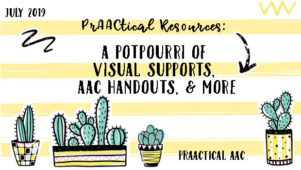
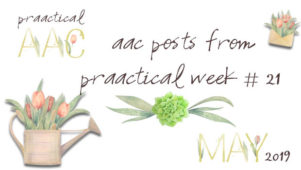
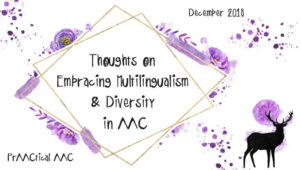

3 Comments
Great post!! Love the detail to the activity.
I LOVE this post! Carlos Andres LOVES to cook with me and these are some great ideas to extend the experience! (He has a G-tube too)We read the directions/recipe together and then discuss the sequence of what we will do! I always talk about the shapes of the pans and spoons etc. and he loves when we use eggs and sing: bang, bang,bang, splat! ;> Great idea for the writing portion at the end. We will have to add this to our cooking repertouire!!
Thanks for the great ideas!!
Shelly Alvarez (and Carlos too!;)
So nice of you to take the time to comment, Shelly! I can definitely see how Carlos would love the active engagement in cooking. Learners love learning! Cooking offers such a rich array of possibilities, from choosing the recipe, to shopping for ingredients, to sharing the finished masterpiece. So many prAACtical language and literacy opportunities!